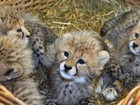Two young cheetahs that escaped from an Austrian zoo overnight returned to their enclosure a few hours later, led home by their mother's calls, the zoo said Tuesday.
"Their mother called them and they followed her cries," said Christine Beck, a spokeswoman at the zoo located near Salzburg.
 Full Story
Full Story
A Swiss adventurer took off Tuesday into the night skies above Madrid and headed for Rabat on the world's first intercontinental flight in a solar-powered plane.
Bertrand Piccard, 54-year-old psychiatrist and balloonist, piloted the Solar Impulse plane, a giant as big as an Airbus A340 but as light as an average family car, on the daring voyage from Europe to Africa.
 Full Story
Full Story
When Venus next week eclipses Earth, an event that will not occur again for more than a century, millions of sky gazers may have romantic thoughts about our closest neighbor and its twilight beauty.
But the truth is that Venus is a hell that would have surpassed even the imagination of Dante, and it has caused more grief and disappointment than any other planet in the Solar System.
 Full Story
Full Story
The prototype space shuttle that arrived in New York City by air earlier this spring is on the move again, this time by sea.
The Enterprise had been parked at Kennedy Airport since it flew from Washington to New York atop a 747 jet.
 Full Story
Full Story
In the late eighth century, Earth was hit by a mystery blast of cosmic rays, according to a Japanese study that found a relic of the powerful event in cedar trees.
Analysis of two ancient trees found a surge in carbon-14 -- a carbon isotope that derives from cosmic radiation -- which occurred just in AD 774 and AD 775, the team report in the journal Nature on Sunday.
 Full Story
Full Story
The French government is to ban a pesticide made by Swiss giant Syngenta used in rapeseed cultivation that has been found to shorten bees' lifespan, Agriculture Minister Stephane Le Foll said Friday.
"I have warned the group that sells Cruiser that I envisage withdrawing the licence to market," Le Foll said after the National Food, Environment and Work Safety Agency (ANSES) issued a damning report on the pesticide.
 Full Story
Full Story
UNESCO on Saturday urged decisive action from Australia to protect the Great Barrier Reef from a gas and mining boom, warning it risked being put on its list of world heritage sites deemed "in danger".
Australia is riding an unprecedented wave of resources investment due to booming demand from Asia, with projects worth Aus$450 billion (U.S. $435 billion) in the pipeline.
 Full Story
Full Story
Nearly a year after they joined the periodic table, two man-made elements have been officially named.
What used to be element 114 is now flerovium, honoring the Flerov Laboratory of Nuclear Reactions in Dubna, Russia, where it was created. Element 116 is now livermorium, for the Lawrence Livermore National Laboratory in Livermore, Calif., home of a scientific team that participated in its creation in Dubna. The chemical symbols are Fl and Lv.
 Full Story
Full Story
U.S. company SpaceX's cargo vessel Thursday splash landed in the Pacific Ocean, capping a successful mission to the International Space Station that blazed a new path for private spaceflight.
"This really couldn't have gone better," said SpaceX chief executive Elon Musk after the unmanned capsule landed in the waters off the Mexican coast at 11:42 am Eastern time (1542 GMT).
 Full Story
Full Story
Our galaxy is on a collision course with its nearest neighbor, Andromeda, and the head-on crash is expected in four billion years, the U.S. space agency NASA said on Thursday.
Astronomers have long theorized that a clash of these galaxy titans was on the way, though it was unknown how severe it might be, or when, with guesses ranging from three to six billion years.
 Full Story
Full Story



